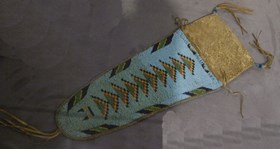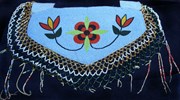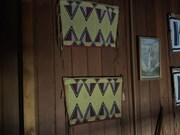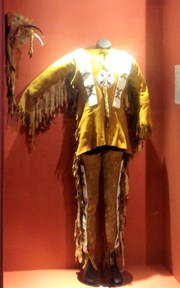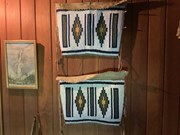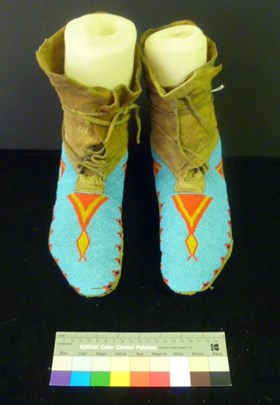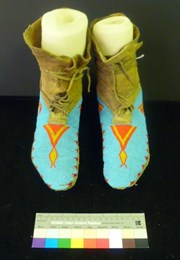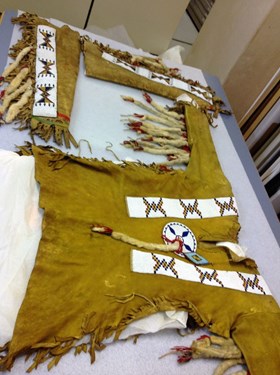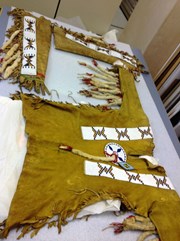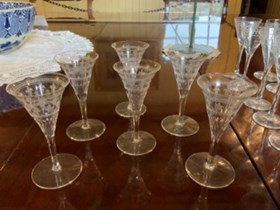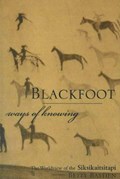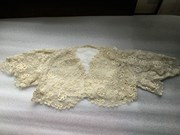Narrow Results By
- Webstad, Phyllis 2
- Adese, Jennifer 1
- Allan, Melissa 1
- Bastien, Betty 1
- Black, Liza 1
- Blondin, Walter; Blondin, George; Goose, Leanne; Mountain, Antoine; Stewart, Sarah; Yakeleya, Raymond; and Dene Elders; foreword by Blondin, Walter. 1
- Brown, Chester 1
- Carlson-Manathara, Elizabeth and Rowe, Gladys 1
- Delehanty Pearkes, Eileen 1
- Dion, Susan D. 1
- Duncan, Dayton and Burns, Ken 1
- Graham, Mary 1
Aboriginal TM : the cultural and economic politics of recognition
https://archives.whyte.org/en/permalink/catalogue25713
- Medium
- Library - Book (including soft-cover and pamphlets)
- Published Date
- 2022
- Author
- Adese, Jennifer
- Publisher
- Winnipeg, Manitoba, Canada : University of Manitoba Press
- Call Number
- 07.2 A3a
- Author
- Adese, Jennifer
- Publisher
- Winnipeg, Manitoba, Canada : University of Manitoba Press
- Published Date
- 2022
- Physical Description
- x, 260 pages : illustrations ; 24 cm
- Subjects
- Indigenous
- Indigenous Culture
- Indigenous People
- Indigenous Traditions
- Tourism
- Language
- Politics
- Abstract
- In Aboriginal™, Jennifer Adese explores the origins, meaning, and usage of the term "Aboriginal" and its displacement by the word "Indigenous." In the Constitution Act, 1982, the term's express purpose was to speak to the "aboriginal rights" acknowledged in Section 35(1). Yet in the wake of the Constitution's passage, Aboriginal, in its capitalized form, became far more closely aligned with Section 35(2)'s interpretation of which specific groups held those rights, and was increasingly used to describe and categorize people. More than simple legal and political vernacular, the term Aboriginal (capitalized or not) has had real-world consequences for the people it defined. Aboriginal™ argues the term was a tool used to advance Canada's cultural and economic assimilatory agenda throughout the 1980s until the mid-2010s. Moreover, Adese illuminates how the word engenders a kind of "Aboriginalized multicultural" brand easily reduced to and exported as a nation brand, economic brand, and place brand--at odds with the diversity and complexity of Indigenous peoples and communities. In her multi-disciplinary research, Adese examines the discursive spaces and concrete sites where Aboriginality features prominently: the Constitution Act, 1982; the 2010 Vancouver Olympics; the "Aboriginal tourism industry"; and the Vancouver International Airport. Reflecting on the term's abrupt exit from public discourse and the recent turn toward Indigenous, Indigeneity, and Indigenization, Aboriginal™ offers insight into Indigenous-Canada relations, reconciliation efforts, and current discussions of Indigenous identity, authenticity, and agency. -- Provided by publisher.
- Contents
- Introduction -- 1. Aboriginal, aboriginality, aboriginalism, aboriginalization: what's in a word? -- Aboriginalized multiculturalism tm: Canada's olympic national brand -- Selling Aboriginal experiences and authenticity: Canadian and Aboriginal tourism -- Marketing aboriginality and the branding of place: the case of Vancouver international airport -- Conclusion: thoughts on the end of aboriginalization and the turn to indigenization.
- Notes
- Title appears with the trademark symbol after the word "Aboriginal".
- ISBN
- 9781772840056
- Accession Number
- P2023.09
- Call Number
- 07.2 A3a
- Collection
- Archives Library
This material is presented as originally created; it may contain outdated cultural descriptions and
potentially offensive content.
Read more.
Adjusting the lens : Indigenous activism, colonial legacies, and photographic heritage
https://archives.whyte.org/en/permalink/catalogue25525
- Medium
- Library - Book (including soft-cover and pamphlets)
- Published Date
- 2021
- Publisher
- Vancouver, British Columbia : University of British Columbia Press
- Call Number
- 07.2 L62a
- Responsibility
- Edited by Sigrid Lien and Hilde Wallem Nielssen
- Publisher
- Vancouver, British Columbia : University of British Columbia Press
- Published Date
- 2021
- Physical Description
- vi, 312 pages : illustrations (black & white) ; 24 cm
- Abstract
- Adjusting the Lens explores the role of photography in contemporary renegotiations of the past and in Indigenous art activism. In moving and powerful case studies, contributors analyze photographic practices and heritage related to Indigenous communities in Canada, Australia, Greenland, Norway, Sweden, Finland, and the United States. In the process, they call attention to how Indigenous people are using old photographs in new ways to empower themselves, revitalize community identity, and decolonize the colonial record. Adjusting the Lens presents original research in this emerging field in Indigenous photography studies, juxtaposing the historical and the contemporary across a range of geographically and culturally distinctive contexts. The transnational perspective of this exciting collection challenges old ways of thinking and meaningfully advances the crucially important project of reclamation. -- Provided by publisher
- Contents
- Reading a Regional Colonial Photographic Archive: Residential Schools in Southern Alberta, 1880-1974 / Carol Williams ; Camera Encounters: Bourgeois Settler Women's Adentures in Sami Areas of Norway / Sigrid Lien and Hilde Wallem Nielssen ; Negotiating Meaning: John Moller's Photographs in Early Twentieth-Century Scandinavian Literature / Ingeborg Hovik ; Reclaiming Pasts, Reclaiming Futures: Indigenous Re-workings of Historical Photography in North America / Laura Peers ; Distruption and Testimony: Archival Photographs, Project Naming, and Inuit Memory in Nunavut / Carol Payne, with contributions by Beth Greehorn, Piita Irniq, Manitok Thompson, Deborah Kigjugalik Webster, Sally Kate Webster, and Christina Williamson ; "Our Histories" in the Photographs of Others: Sami Approaches to Archival Visual Materials / Veli-Pekka Lehtola ; The Best Day for Me, Looking at These Old Photos: Returning Photographs to Australian Aboriginal and Torres Straight Islander People by Jane Lydon and Donna Oxenham ; On Being with (a Photograph of) Sugar Bush Womxn: Towards Anishinaabe Feminist Archival Research Methods / waaseyaa'sin Chrisitne Sy ; Indigenous Culture Jamming: Suohpanterror and the Art of Articulating a Sami Political Community by Laura Junka-Aikio ; Negotiating Postcolonial Identity: Photography as Archive, Collaborative Aesthetics, and Storytelling in Contemporary Greenland / Mette Sandbye ; Photographic Portraits as Dialogical Contact Zones: The Portrait Gallery of Sapmi - Becoming a Nation at the Arctic University Museum of Norway / Hanne Hammer Stein ; Photographic Studies and Indigenous Photographies: Some Thoughts on Categories, Assumptions, and Theories / Elizabeth Edwards
- ISBN
- 9780774866613
- Accession Number
- P2022.04
- Call Number
- 07.2 L62a
- Collection
- Archives Library
This material is presented as originally created; it may contain outdated cultural descriptions and
potentially offensive content.
Read more.
Ancestors : indigenous peoples of Western Canada in historic photographs
https://archives.whyte.org/en/permalink/catalogue25527
- Medium
- Library - Book (including soft-cover and pamphlets)
- Published Date
- 2021
- Publisher
- Edmonton, Alberta : University of Alberta Library
- Call Number
- 07.2 C24a
- 07.2 C24a copy 2
- Responsibility
- Edited by Sarah Carter and Inez Lightning
- Publisher
- Edmonton, Alberta : University of Alberta Library
- Published Date
- 2021
- Physical Description
- x, 188 pages : illustrations (some color) ; 23 x 24 cm
- Abstract
- This exhibition catalogue introduces historic photographs of Indigenous peoples of Western Canada from a collection housed at the University of Alberta's Bruce Peel Special Collections. The publication focuses on the ancestors represented in the collection and how their images continue to generate stories and meanings in the present. The selected photographs contribute to a richer, deeper understanding of the past. There is strength, character, persistence, determination, artwork, humour, dance, celebration, and so much more in the photographs. Some serve as records of cherished landscapes that may have been altered. Others provide links to ancestors: revered leaders, soldiers, healers, thinkers, and orators. The curators hope that the process of identifying the people in these photographs, only begun here, will continue. (Provided by Publisher)
- Contents
- Foreword / Chief Willie Littlechild ; The nature of the collection and its challenges ; Western Canada in the late Nineteenth and early Twentieth Centuries ; The aims of the curators ; The Exhibition
- ISBN
- 9781551954547
- Accession Number
- P2022.05
- Call Number
- 07.2 C24a
- 07.2 C24a copy 2
- Collection
- Archives Library
This material is presented as originally created; it may contain outdated cultural descriptions and
potentially offensive content.
Read more.
The arts of Indigenous health and well-being
https://archives.whyte.org/en/permalink/catalogue25714
- Medium
- Library - Book (including soft-cover and pamphlets)
- Published Date
- 2021
- Publisher
- Winnipeg, Manitoba, Canada : University of Manitoba Press
- Call Number
- 07.2 S9t
- Responsibility
- Edited by Nancy Van Styvendale, J. D. McDougall, Robert Henry, and Robert Alexander Innes
- Publisher
- Winnipeg, Manitoba, Canada : University of Manitoba Press
- Published Date
- 2021
- Physical Description
- 272 pages : illustrations ; 23 cm
- Subjects
- Indigenous
- Indigenous Culture
- Indigenous Traditions
- Indigenous Peoples
- Health
- Oral History
- Medicine
- Abstract
- Drawing attention to the ways in which creative practices are essential to the health, well-being, and healing of Indigenous peoples, The Arts of Indigenous Health and Well-Being addresses the effects of artistic endeavour on the "good life", or mino-pimatisiwin in Cree, which can be described as the balanced interconnection of physical, emotional, spiritual, and mental well-being. In this interdisciplinary collection, Indigenous knowledges inform an approach to health as a wider set of relations that are central to well-being, wherein artistic expression furthers cultural continuity and resilience, community connection, and kinship to push back against forces of fracture and disruption imposed by colonialism. The need for healing--not only individuals but health systems and practices--is clear, especially as the trauma of colonialism is continually revealed and perpetuated within health systems. The field of Indigenous health has recently begun to recognize the fundamental connection between creative expression and well-being. This book brings together scholarship by humanities scholars, social scientists, artists, and those holding experiential knowledge from across Turtle Island to add urgently needed perspectives to this conversation. Contributors embrace a diverse range of research methods, including community-engaged scholarship with Indigenous youth, artists, Elders, and language keepers. The Arts of Indigenous Health and Well-Being demonstrates the healing possibilities of Indigenous works of art, literature, film, and music from a diversity of Indigenous peoples and arts traditions. This book will resonate with health practitioners, community members, and any who recognize the power of art as a window, an entryway to access a healthy and good life. -- Provided by publisher.
- Contents
- "Art for life's sake": approaches to indigenous arts, health, and well-being / Nancy Van Styvendale, J.D. McDougall, Robert Henry, and Robert Alexander Innes -- What this pouch holds / Gail MacKay -- Baskets, birchbark scrolls, and maps of land: indigenous making practices as oral historiography / Andrea Riley-Mukavetz -- For Kaydence and her cousins: health and happiness in cultural legacies and contemporary contexts / Adesola Akinleye -- Stories and staying power: artmaking as (re)source of cultural resilience and well-being for Panniqtumiut / Alena Rosen -- Healthy connections: facilitator's perceptions of programming linking arts and wellness with indigenous youth / Mamata Pandey, Nuno F. Ribeiro, Warren Linds, Linda M. Goulet, Jo-Ann Episkenew, and Karen Schmidt -- The doubleness of sound in Canada's Indian residential schools / Beverley Diamond -- Kissed by lightning: mediating Haudenosaunee traditional teachings through film / Nicholle Dragone -- Minobimaadiziwinke (creating a good life): native bodies healing / Petra Kuppers and Margaret Noodin -- Body counts: war, pesticides, and queer spirituality in Cherri´e Moraga's Heroes and saints / Desiree Hellegers -- The language of soul and ceremony / Louise Halfe -- Sa^kihiwa^win: land's overflow into the space-tial "otherwise" / Karyn Recollet.
- ISBN
- 9780887559396
- Accession Number
- P2023.09
- Call Number
- 07.2 S9t
- Collection
- Archives Library
This material is presented as originally created; it may contain outdated cultural descriptions and
potentially offensive content.
Read more.
Bead by bead : constitutional rights and Métis community
https://archives.whyte.org/en/permalink/catalogue25524
- Medium
- Library - Book (including soft-cover and pamphlets)
- Published Date
- 2021
- Publisher
- Vancouver, British Columbia : University of British Columbia Press
- Call Number
- 07.2 B71b
- Responsibility
- Edited by Yvonne Boyer and Larry Chartrand
- Publisher
- Vancouver, British Columbia : University of British Columbia Press
- Published Date
- 2021
- Physical Description
- xii, 221 pages ; 24 cm
- Subjects
- Indigenous
- Metis
- Canada
- Politics
- Colonialism
- Identity
- Abstract
- What does the phrase Me´tis peoples mean in constitutional terms? As lawyers and scholars dispute forms of Me´tis identity, and debate the nature and scope of Me´tis rights under the Canadian Constitution, understanding Me´tis experience of colonization is fundamental to achieving reconciliation. In Bead by Bead, contributors address the historical denial - at both federal and provincial levels - of outstanding Me´tis concerns and Aboriginal rights claims, in particular with respect to land, resources, and governance. Tackling such themes as ongoing colonial policies, the invisibility of Me´tis women in court decisions, identity politics, and racist legal principles, they uncover the troubling issues that plague Me´tis aspirations for a just future. This nuanced analysis of the parameters that current Indigenous legal doctrines place around Me´tis rights discourse moves beyond a one-size-fits-all definition of Me´tis or a uniform approach to Aboriginal rights. By raising critical questions about self-determination, colonization, kinship, land, and other essential aspects of Me´tis lived reality, these clear-eyed essays go beyond legal theorizing and create pathways to respectful, inclusive Me´tis-Canadian constitutional relationships. (Provided by Publisher)
- Contents
- Me´tis identity captured by law: struggles over use of the category Me´tis in Canadian law / Se´bastien Grammond ; Recognition and reconciliation: recent developments in Me´tis rights law / Thomas Isaac ; Shifting the status quo: the duty to consult and the Me´tis of British Columbia / Christopher Gall and Brodie Douglas ; The resilience of Me´tis title: rejecting assumptions of extinguishment / Karen Drake and Adam Gaudry ; Where are the women? Analyzing the three Me´tis Supreme Court of Canada decisions / Brenda L. Gunn ; Manitoba Me´tis Federation and Daniels: "post-legal" reconciliation and Western Me´tis / Jeremy Patzer ; Colonial ideologies: the denial of Me´tis political identity in Canadian law / D'Arcy Vermette ; Me´tis Aboriginal rights: four legal doctrines / Darren O'Toole ; Suzerainty, sovereignty, jurisdiction: the future of Me´tis ways / Signa A. Daum Shanks.
- ISBN
- 9780774865975
- Accession Number
- P2022.04
- Call Number
- 07.2 B71b
- Collection
- Archives Library
This material is presented as originally created; it may contain outdated cultural descriptions and
potentially offensive content.
Read more.
- Date
- 1870 – 1900
- Material
- skin, deer; glass
- Catalogue Number
- 103.08.0003
- Description
- A long, narrow, curve bottomed flat bag with a rounded flap. The bag has a leather tassel hanging from the bottom edge. The front of the bag is completely beaded with a light blue background and a column of triangles of green, red, yellow and blue beads.
1 image
- Title
- Beaded Bag
- Date
- 1870 – 1900
- Material
- skin, deer; glass
- Dimensions
- 15.0 x 44.5 cm
- Description
- A long, narrow, curve bottomed flat bag with a rounded flap. The bag has a leather tassel hanging from the bottom edge. The front of the bag is completely beaded with a light blue background and a column of triangles of green, red, yellow and blue beads.
- Subject
- Indigenous, Stoney
- decorative
- regalia
- beadwork
- Credit
- Gift of Pearl Evelyn Moore, Banff, 1979
- Catalogue Number
- 103.08.0003
Images
This material is presented as originally created; it may contain outdated cultural descriptions and
potentially offensive content.
Read more.
- Date
- 1875 – 1925
- Material
- glass; skin; fibre
- Catalogue Number
- 103.01.0067
- Description
- A heavily beaded yoke, edged with beaded loop lace, to be worn over the shoulders and hanging in front and back with a point at the middle. Completely covered with blue background beading and simple large stylized four-petalled flower in red with black at inner part of each petal around red centre,…
1 image
- Title
- Beaded Collar
- Date
- 1875 – 1925
- Material
- glass; skin; fibre
- Dimensions
- 43.0 x 36.0 cm
- Description
- A heavily beaded yoke, edged with beaded loop lace, to be worn over the shoulders and hanging in front and back with a point at the middle. Completely covered with blue background beading and simple large stylized four-petalled flower in red with black at inner part of each petal around red centre, and four elongated green leaves, one between each petal. Long black stems curving off to each side hold three-pointed blossom of dark green and orange outlined in lighter green with two dark green leaves beneath. Same motif repeated on back but slight colour variations. Entire yoke edged with wide, looped netting of cylindrical beads forming lace like effect with strings of buckskin threaded with beads hanging from the outermost edge. Netting beads of transparent amber, green, turquoise, white, and red.
- Credit
- Gift of Catharine Robb Whyte, O. C., Banff, 1979
- Catalogue Number
- 103.01.0067
Images
This material is presented as originally created; it may contain outdated cultural descriptions and
potentially offensive content.
Read more.
- Date
- 1870 – 1890
- Material
- skin, deer; glass
- Catalogue Number
- 103.05.0005 a,b
- Description
- A pair of completely beaded leggings with a deerskin flap. These leggings tie around the legs with thongs. The beadwork is of a yellow background with pink, red and blue triangular design.
1 image
- Title
- Beaded Leggings
- Date
- 1870 – 1890
- Material
- skin, deer; glass
- Dimensions
- 32.0 x 30.0 cm
- Description
- A pair of completely beaded leggings with a deerskin flap. These leggings tie around the legs with thongs. The beadwork is of a yellow background with pink, red and blue triangular design.
- Subject
- Indigenous
- Blood
- Peigan
- beadwork
- decorative
- regalia
- Credit
- Gift of Pearl Evelyn Moore, Banff, 1979
- Catalogue Number
- 103.05.0005 a,b
Images
This material is presented as originally created; it may contain outdated cultural descriptions and
potentially offensive content.
Read more.
- Date
- 1875 – 1890
- Material
- skin; skin, ermine; hair, sheep; glass; fibre
- Catalogue Number
- 103.05.0010 a,b
- Description
- Natural skin leggings fringed along the length of one side. A beaded strip along the outside length of each legging has a white background with a coloured design. There are ermine tails fastened into the fringe. The fringe is approximately 10 cm long.
1 image
- Title
- Beaded Leggings
- Date
- 1875 – 1890
- Material
- skin; skin, ermine; hair, sheep; glass; fibre
- Dimensions
- 27.0 x 71.0 cm
- Description
- Natural skin leggings fringed along the length of one side. A beaded strip along the outside length of each legging has a white background with a coloured design. There are ermine tails fastened into the fringe. The fringe is approximately 10 cm long.
- Credit
- Gift of Pearl Evelyn Moore, Banff, 1979
- Catalogue Number
- 103.05.0010 a,b
Images
This material is presented as originally created; it may contain outdated cultural descriptions and
potentially offensive content.
Read more.
- Date
- 1875 – 1900
- Material
- skin; fibre, cotton; glass
- Catalogue Number
- 103.05.0045 a,b
- Description
- A pair of beaded leggings worn on the leg from the knee to the ankle. The leggings tie on at the back of the leg with thongs. The leggings have a design of three vertical stripes and two diamond shapes of yellow, red, green and blue on a white background.
1 image
- Title
- Beaded Leggings
- Date
- 1875 – 1900
- Material
- skin; fibre, cotton; glass
- Dimensions
- 35.0 x 30.0 cm
- Description
- A pair of beaded leggings worn on the leg from the knee to the ankle. The leggings tie on at the back of the leg with thongs. The leggings have a design of three vertical stripes and two diamond shapes of yellow, red, green and blue on a white background.
- Subject
- Indigenous
- Blood
- Blackfoot
- Siksika
- decorative
- regalia
- beadwork
- Credit
- Gift of Pearl Evelyn Moore, Banff, 1979
- Catalogue Number
- 103.05.0045 a,b
Images
This material is presented as originally created; it may contain outdated cultural descriptions and
potentially offensive content.
Read more.
Beaded Moccasins
https://archives.whyte.org/en/permalink/artifact103.03.1021%20a%2cb
- Date
- 1875 – 1925
- Material
- skin; glass
- Catalogue Number
- 103.03.1021 a,b
- Description
- Men’s traditional moccasins made of of white tail deer. Completely beaded, pale blue/red/yellow tepee, Rocky Mountain style cut of one piece, pale blue background, red and yellow tepee design on toe, red and yellow bow design along each side of foot, sole edge trimmed in stepped red and dark blue m…
1 image
- Title
- Beaded Moccasins
- Date
- 1875 – 1925
- Material
- skin; glass
- Dimensions
- 26.5 x 12.5 x 26.5 cm
- Description
- Men’s traditional moccasins made of of white tail deer. Completely beaded, pale blue/red/yellow tepee, Rocky Mountain style cut of one piece, pale blue background, red and yellow tepee design on toe, red and yellow bow design along each side of foot, sole edge trimmed in stepped red and dark blue motifs, large soft ankle flap, small, rectangular tongue, long buckskin laces, soles patched at heel and ball of foot.
- Subject
- Indigenous
- Stoney
- regalia
- beadwork
- Credit
- Gift of Unknown, 1968
- Catalogue Number
- 103.03.1021 a,b
Images
This material is presented as originally created; it may contain outdated cultural descriptions and
potentially offensive content.
Read more.
Beaded Moccasins
https://archives.whyte.org/en/permalink/artifact103.03.0005%20a%2cb
- Date
- 1870 – 1880
- Material
- skin; glass
- Catalogue Number
- 103.03.0005 a,b
- Description
- A pair of soft moccasins with parfleche soles and a thong threaded through holes at the ankle for tying. The beadwork is of yellow, red and blue geometric design in a wide strip from the ankle, along the instep to the toe. There is also a narrow strip of beadwork vertically along the back of the he…
1 image
- Title
- Beaded Moccasins
- Date
- 1870 – 1880
- Material
- skin; glass
- Dimensions
- 25.0 cm
- Description
- A pair of soft moccasins with parfleche soles and a thong threaded through holes at the ankle for tying. The beadwork is of yellow, red and blue geometric design in a wide strip from the ankle, along the instep to the toe. There is also a narrow strip of beadwork vertically along the back of the heel.
- Credit
- Gift of Pearl Evelyn Moore, Banff, 1979
- Catalogue Number
- 103.03.0005 a,b
Images
This material is presented as originally created; it may contain outdated cultural descriptions and
potentially offensive content.
Read more.
Beaded Moccasins
https://archives.whyte.org/en/permalink/artifact103.03.0003%20a%2cb
- Date
- 1870 – 1880
- Material
- skin; glass
- Catalogue Number
- 103.03.0003 a,b
- Description
- A pair of soft moccasins with a fringe along the back of the heel. There is a casing at the ankle for a thong used to tie the moccasins on the foot. These moccasins are completely beaded on the uppers with the exception of an area of the ankle. The design is on a blue background except for the in…
1 image
- Title
- Beaded Moccasins
- Date
- 1870 – 1880
- Material
- skin; glass
- Dimensions
- 23.0 cm
- Description
- A pair of soft moccasins with a fringe along the back of the heel. There is a casing at the ankle for a thong used to tie the moccasins on the foot. These moccasins are completely beaded on the uppers with the exception of an area of the ankle. The design is on a blue background except for the instep which is white with a stepped triangle which has a cross at its tip. The colours of beads are: blue, white, red, dark blue, and black.
- Subject
- Indigenous
- decorative
- beadwork
- regalia
- Credit
- Gift of Pearl Evelyn Moore, Banff, 1979
- Catalogue Number
- 103.03.0003 a,b
Images
This material is presented as originally created; it may contain outdated cultural descriptions and
potentially offensive content.
Read more.
- Date
- 1875 – 1890
- Material
- skin, deer; skin, ermine; hair, sheep; glass
- Catalogue Number
- 103.05.0011
- Description
- A man's deerskin shirt with fringe at the ends of the sleeves. The shirt has strips of beadwork at the shoulders that extend down both the front and back of the garment with a fringe of ermine tails along the length of the outside edge. The background of the beadwork is white with an x-shaped pa…
1 image
- Title
- Beaded Shirt
- Date
- 1875 – 1890
- Material
- skin, deer; skin, ermine; hair, sheep; glass
- Dimensions
- 53.0 (shoulder) x 81.0 cm
- Description
- A man's deerskin shirt with fringe at the ends of the sleeves. The shirt has strips of beadwork at the shoulders that extend down both the front and back of the garment with a fringe of ermine tails along the length of the outside edge. The background of the beadwork is white with an x-shaped pattern of blue, yellow and red. There is a medallion of beadwork in the centre of both the front and back of the shirt, with an ermine tail hanging from the centre of each medallion.
- Credit
- Gift of Pearl Evelyn Moore, Banff, 1979
- Catalogue Number
- 103.05.0011
Images
This material is presented as originally created; it may contain outdated cultural descriptions and
potentially offensive content.
Read more.
- Date
- 1875 – 1900
- Material
- glass
- Catalogue Number
- 104.20.0107 a-f
- Description
- A set of six cone shaped clear crystal glasses on stems with round bases. The rim of each glass is slightly flared and a band of fleur-de-lis is etched around each glass near the top (one glass has two bands of fleur-de-lis). The point of each glass, where it joins the stem, has a fluted pattern …
1 image
- Title
- Beverage Set
- Date
- 1875 – 1900
- Material
- glass
- Dimensions
- 11.0 cm
- Description
- A set of six cone shaped clear crystal glasses on stems with round bases. The rim of each glass is slightly flared and a band of fleur-de-lis is etched around each glass near the top (one glass has two bands of fleur-de-lis). The point of each glass, where it joins the stem, has a fluted pattern cut into the glass.
- Subject
- households
- social customs
- decorative
- symbols
- Credit
- Gift of Pearl Evelyn Moore, Banff, 1979
- Catalogue Number
- 104.20.0107 a-f
Images
This material is presented as originally created; it may contain outdated cultural descriptions and
potentially offensive content.
Read more.
Beyond the orange shirt story
https://archives.whyte.org/en/permalink/catalogue25692
- Medium
- Library - Book (including soft-cover and pamphlets)
- Published Date
- 2021
- Author
- Webstad, Phyllis
- Publisher
- Medicine Wheel Publishing
- Call Number
- 07.2 W39b
- Author
- Webstad, Phyllis
- Publisher
- Medicine Wheel Publishing
- Published Date
- 2021
- Physical Description
- 102 pages
- Abstract
- Beyond the Orange Shirt Story is a unique collection of truths that articulate the lives and experiences of some Residential School Survivors and their families. Compiled by Phyllis Webstad, Residential School Survivor and Founder of the Orange Shirt Day movement, this book will give readers an up-close look at what life was like for many Survivors -- before, during, and after their Residential School experiences. These personal Survivor accounts, relayed in a number of one on one interviews, are authentically shared in their own voices.-- Provided by Publisher
- Contents
- 1. Phyllis Webstad -- 2. Suzanne Edward Jim (Phyllis Webstad's great-grandmother) -- 3. Helena (Lena) Jack (Nee Billy) (Phyllis Webstad's grandmother) -- 4. Rose Wilson Nee Jack (Phyllis Webstad's mother) -- 5. Theresa Jack (Phyllis Webstad's auntie) -- 6. Hazel Agness Jack (Phyllis Webstad's auntie) -- 7. Jeremy Boston (Phyllis Webstad's son) -- 8. Mason and Blake Murphy (Phyllis Webstad's grandchildren) -- 9. Lynn Eberts (Phyllis Webstad's elementary school teacher) -- 10. Photos of Phyllis Webstad's family -- 11. St. Joseph's Mission Residential School.
- ISBN
- 9781989122754
- Accession Number
- P2022.14
- Call Number
- 07.2 W39b
- Collection
- Archives Library
This material is presented as originally created; it may contain outdated cultural descriptions and
potentially offensive content.
Read more.
Blackfoot ways of knowing : the worldview of the Siksikaitsitapi
https://archives.whyte.org/en/permalink/catalogue26211
- Medium
- Library - Book (including soft-cover and pamphlets)
- Published Date
- 2023
- Author
- Bastien, Betty
- Publisher
- Calgary : University of Calgary Press
- Edition
- 9th printing
- Call Number
- 07.2 B29b
- Author
- Bastien, Betty
- Responsibility
- Ju¨rgen W. Kremer, editor ; Duane Mistaken Chief, language consultant.
- Edition
- 9th printing
- Publisher
- Calgary : University of Calgary Press
- Published Date
- 2023
- Physical Description
- xx, 235 pages : illustrations, portraits ; 23 cm
- Subjects
- Blackfoot
- Siksikaitsitapi
- Indigenous
- Indigenous Culture
- Indigenous Customs
- Indigenous People
- Indigenous Traditions
- Indigenous Language
- Abstract
- The worldview of the Siksikaitsitapi is a journey into the heart and soul of Blackfoot culture. In sharing her personal story of coming home to reclaim her identity within that culture, Betty Bastien offers us a gateway into traditional Blackfoot ways of understanding and experiencing the world. As a scholar and researcher, Bastien is also able to place Blackfoot tradition within the context of knowledge building among indigenous peoples generally, and within an historical context of precarious survival amid colonial displacement and cultural genocide. -- From back cover
- Contents
- Context -- Introduction -- Innahkootaitsinnika'topi -- History of the Blackfoot-speaking tribes -- Introductory remarks -- Iitotasimahpi Iimitaiks -- The era of the dog or the time of the ancestors (Pre-eighteenth century) -- Ao'ta'sao'si Ponokaomita -- the era of the horse (eighteeneth century to 1880) -- Ao'maopao'si -- from when we settled in one place (1880) to today -- Cultural destruction -- policies of ordinary genocide -- Tribal protocol and affirmative inquiry -- Niinohkanistssksinipi -- Speaking personally -- Traditional knowledge in academe -- Cultural affirmation -- Protocol of affirmative inquiry -- Affirmation of indigenous knowledge -- Kakyosin -- traditional knowledge -- Kiitomohpiipotoko -- ontological responsibilities -- Siksikaitsitapi ways of knowing -- epistemology -- Knowledge is coming to know Ihtsipaitapiiyo'pa -- Kakyosin/Mokaksin -- Indigenous learning -- Niisi'powahsinni-language -- Aipommotsspistsi -- transfers -- Kaaahsinnooniksi -- grandparents -- Conclusion: renewal of ancestral responsibilities as antidote to genocide -- Deconstructing the colonized mind -- Eurocentred and Niitsitapi identity -- Reflections and implications.
- ISBN
- 9781552381090
- Accession Number
- P2023.25
- Call Number
- 07.2 B29b
- Collection
- Archives Library
This material is presented as originally created; it may contain outdated cultural descriptions and
potentially offensive content.
Read more.
Blood memory : the tragic decline and improbable resurrection of the American Buffalo
https://archives.whyte.org/en/permalink/catalogue26204
- Medium
- Library - Book (including soft-cover and pamphlets)
- Published Date
- 2023
- Author
- Duncan, Dayton and Burns, Ken
- Publisher
- New York : Alfred A. Knopf
- Call Number
- 08 D91b
- Publisher
- New York : Alfred A. Knopf
- Published Date
- 2023
- Physical Description
- xvi, 329 pages : illustrations (chiefly color) ; 24 cm
- Subjects
- Buffalo
- Pablo-Allard buffalo round-up
- Conservation
- Indigenous
- Colonialism
- Environment
- Ecology
- Abstract
- The epic story of the buffalo in America, from prehistoric times to today--a moving and beautifully illustrated work of natural history. The American buffalo--our nation's official mammal-is an improbable, shaggy beast that has found itself at the center of many of our most mythic and sometimes heartbreaking tales. The largest land animals in the Western Hemisphere, they are survivors of a mass extinction that erased ancient species that were even larger. For nearly 10,000 years, they evolved alongside Native people who weaved them into every aspect of daily life; relied on them for food, clothing, and shelter; and revered them as equals. Newcomers to the continent found the buffalo fascinating at first, but in time they came to consider them a hindrance to a young nation's expansion. And in the space of only a decade they were slaughtered by the millions for their hides, with their carcasses left to rot on the prairies. Then, teetering on the brink of disappearing from the face of the earth, they would be rescued by a motley collection of Americans, each of them driven by different--and sometimes competing--impulses. This is the rich and complicated story of a young republic's heedless rush to conquer a continent, but also of the dawn of the conservation era--a story of America at its very best and worst -- Provided by publisher.
- Contents
- Part 1: The Trail to Extinction -- The Buffalo and the People -- Strangers -- Omen in the Skies -- The Iron Horse -- Kills Tomorrow -- Part 2: Back From the Brink -- A Death Wind for My People -- Just in the Nick of Time -- Changes of Heart -- Ghosts -- The Last Refuge -- Blood Memory -- Big Medicine.
- Notes
- Dayton Duncan ; based on a documentary film by Ken Burns ; written by Dayton Duncan ; with an introduction by Ken Burns ; picture research by Emily Mosher and Susan Shumaker ; design by Maggie Hinders.
- Whyte Museum archival collections utilized.
- ISBN
- 9780593537343
- Accession Number
- P2023.25
- Call Number
- 08 D91b
- Collection
- Archives Library
This material is presented as originally created; it may contain outdated cultural descriptions and
potentially offensive content.
Read more.
- Date
- 1870 – 1910
- Material
- fibre
- Catalogue Number
- 103.05.0070
- Description
- A short white lace woman’s jacket (small size) with cape sleeves. The lace is worked in an asymetrical floral pattern that is quite large and definite.
1 image
- Title
- Bolero
- Date
- 1870 – 1910
- Material
- fibre
- Dimensions
- 40.5 x 42.0 cm
- Description
- A short white lace woman’s jacket (small size) with cape sleeves. The lace is worked in an asymetrical floral pattern that is quite large and definite.
- Credit
- Gift of Pearl Evelyn Moore, Banff, 1979
- Catalogue Number
- 103.05.0070
Images
This material is presented as originally created; it may contain outdated cultural descriptions and
potentially offensive content.
Read more.
- Date
- 1870 – 1910
- Material
- fibre
- Catalogue Number
- 103.05.0071
- Description
- A woman’s (size small) short white lace jacket, with short sleeves, that is rounded and open at the front. The jacket has scalloped lace edges.
1 image
- Title
- Bolero
- Date
- 1870 – 1910
- Material
- fibre
- Dimensions
- 47.0 x 38.0 cm
- Description
- A woman’s (size small) short white lace jacket, with short sleeves, that is rounded and open at the front. The jacket has scalloped lace edges.
- Subject
- households
- clothing
- decorative
- Credit
- Gift of Pearl Evelyn Moore, Banff, 1979
- Catalogue Number
- 103.05.0071
Images
This material is presented as originally created; it may contain outdated cultural descriptions and
potentially offensive content.
Read more.






